Construction of Hoover Dam
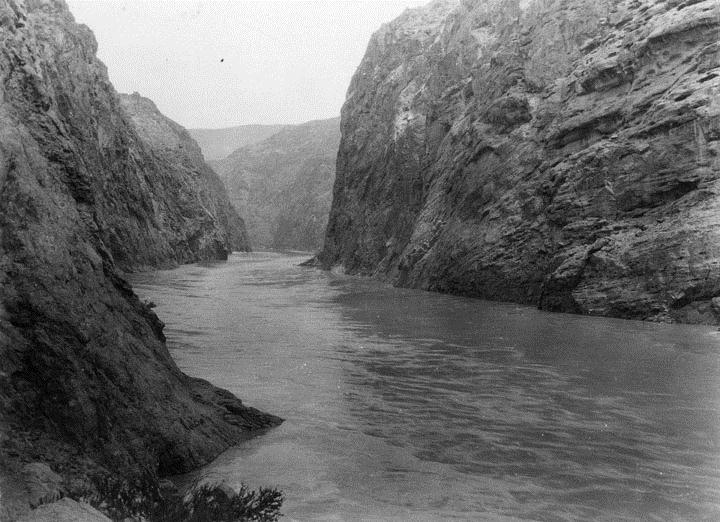 |
|
| (1930)* - Black Canyon - The future site of Hoover Dam. |
BackgroundHoover Dam was constructed between 1931 and 1936 during the Great Depression. Its main purpose was to harness the Colorado River to prevent periodic catastrophic flooding, to allocate and distribute water, and to generate hydroelectricity for the Southwest. Even by today's standards Hoover Dam was a gigantic project. At the time it was the world's largest project made with concrete, not to mention the largest public works project in US history. The dam's completion had a significant impact on Southern California and in particular Los Angeles, since the power generated by the dam contributed to more than 70% of the City's power needs at the time. |
 |
|
| (1925)^* - "The Party" about to embark for a trip through Boulder Canyon. They are assessing the potential sites for a dam on the Colorado River. |
Historical Notes Members of a water resources consulting committee (F. E. Bonner, A. J. Cleary, G. A. Elliot, B. A. Etcheverry, F. C. Herrmann, Louis C. Hill, W. L. Huber, A. Kempkey, J. B. Lippincott, William Mulholland, and C.S. Ridley) prepare to embark on a trip down the Colorado river, through Boulder Canyon, with representatives of the City of Los Angeles (William Mullholland, H. A. Van Norman, E. A. Bayley, H. C. Gardett, and S. Parratt) and the State of California (Paul Bailey and Gerald Jones).^* More than 200 engineers worked to design the dam that would be constructed in Black Canyon. It would be the highest concrete arch dam in the United States, and the largest building project that the federal government had ever undertaken.*# |
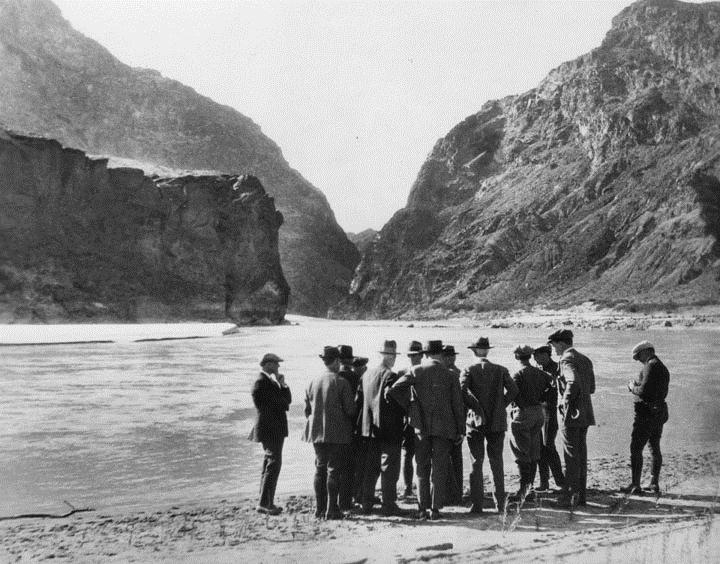 |
|
| (ca. 1928)* - Engineers and politicians view dam site at Black Canyon. |
Historical Notes Before a dam could be built, political work was necessary to resolve the competing claims on the river by different western states. As U.S. secretary of commerce, Herbert Hoover negotiated the Colorado River Compact, which divided the river basin into two regions, lower (Arizona, Nevada and California) and upper (Wyoming, Utah, New Mexico and Colorado) that would make the building of the dam possible. In 1928, after years of lobbying to get a dam-building bill through Congress, the legislation was finally approved as the Boulder Canyon Project Act. Hoover, who that same year was elected as the 31st president of the United States, signed the bill into law in 1929.*# |
 |
|
| (1931)* - The first blast of the dam construction. Cameras are rolling as the blast goes off. |
Historical Notes Construction efforts consisted of re-routing the river through canyon walls, blasting immense amounts of rock and dredging efforts to build on a bedrock foundation, construction of two diversion coffer dams, and pouring 6.6 million tons of concrete. |
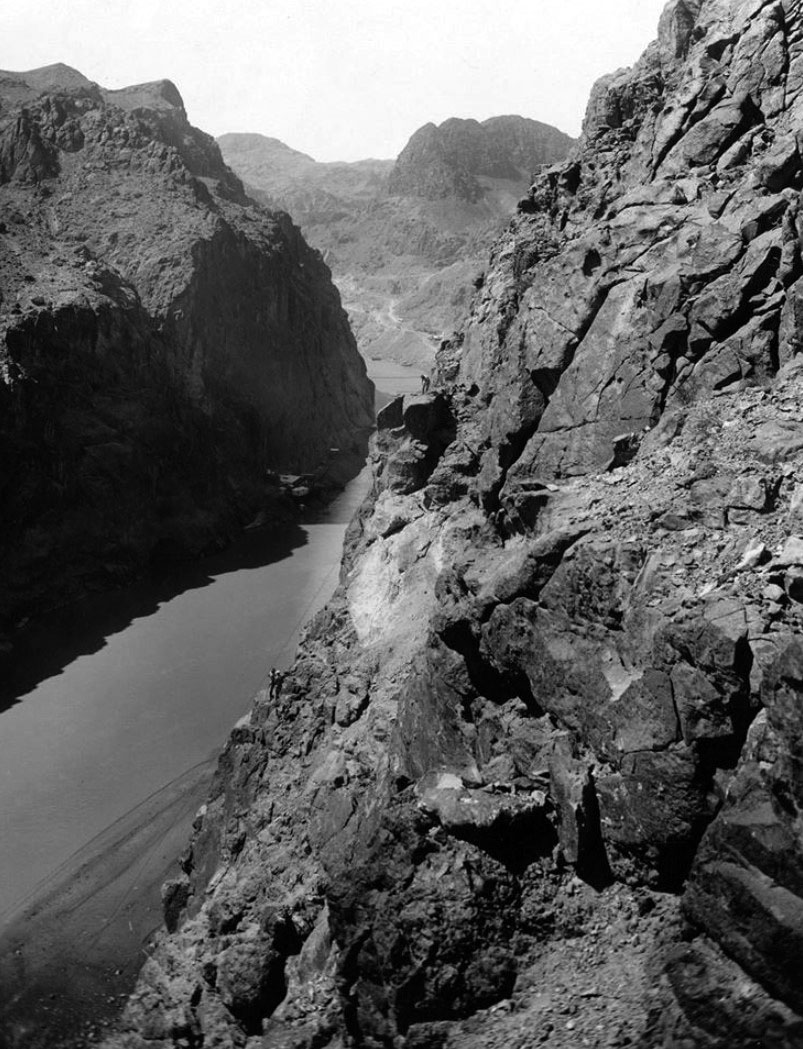 |
|
| (1931)^.^ - Surveyors preparing anchorage lines on the steep canyon walls. |
Historical Notes Black Canyon has a width of from 290 to 370 feet at low-water level, and from 850 to 970 feet at elevation 1,232. The top of the canyon walls is approximately 1,500 elevation. The foundation is a volcanic breccia or tuff, originally an accumulation of fragments of many kinds derived from volcanic eruptions, and now transformed into well-cemented, tough, durable mass of rock standing with remarkably steep walls.* |
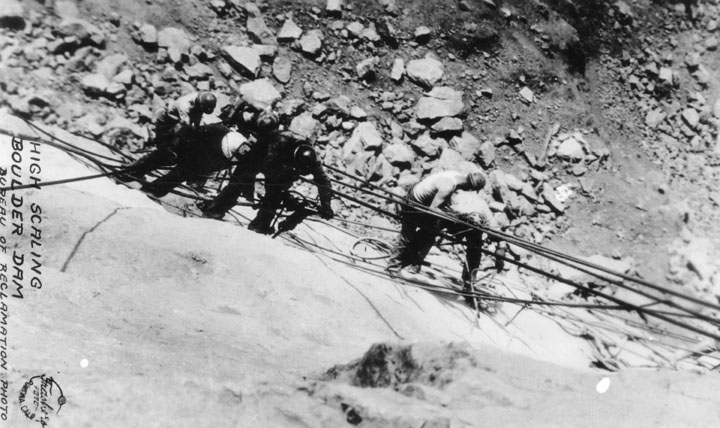 |
|
| (ca. 1931)^^ - Workmen supported by lines from the top as they did high scaling on canyon walls during construction of the dam. |
Historical Notes “High Scalers” climbed down canyon walls on ropes to remove loose and weakened rocks along the canyon walls where the dam walls would join. Descending down the cliffs with the weight of tools, water and food, others would lower jackhammers to drill powder holes. The High Scalers would fill the holes with dynamite and after hand maneuvering out of the way of explosives, they went to work with crowbars to remove loosened rock.*^* |
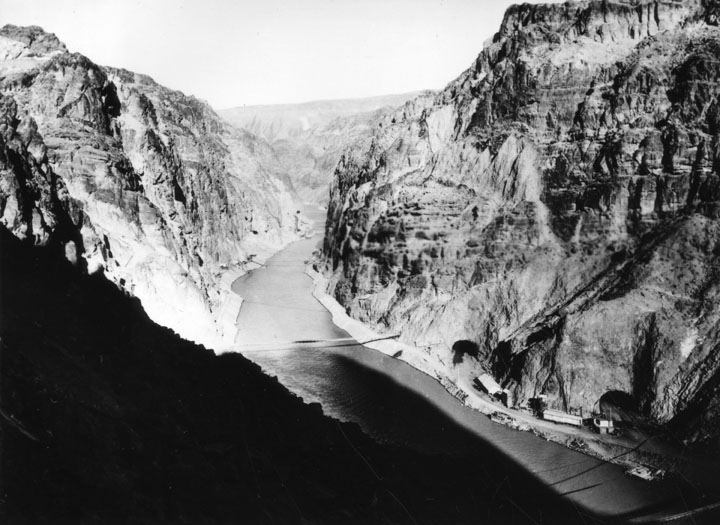 |
|
| (1932)* - View from above the Colorado River looking upstream towards the site of Hoover Dam which is at the bend in the river. On the right we can see the lower portals of the Arizona water diversion tunnels. |
Historical Notes Before construction could begin, the river was diverted around the dam site through four 50-foot-diameter tunnels, two drilled through the canyon walls on each side of the river. The tunnels, with a total combined length of 15,946 feet, or about three miles, were excavated to 56 feet and lined with three feet (300,000 cubic yards) of concrete. They could carry over 200,000 cubic feet - more than 1.5 million gallons - of water per second. The river was first diverted through the two Arizona tunnels on November 14, 1932.*#^ |
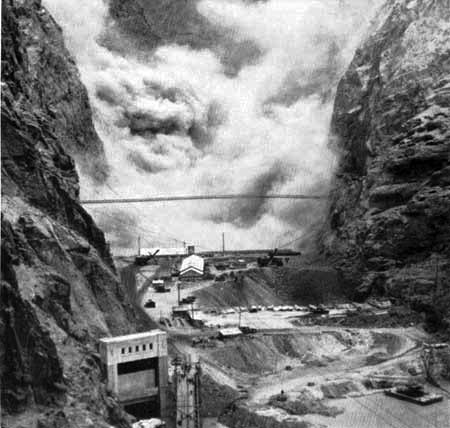 |
(ca. 1932)**# - Blasting away the sides of the canyon. More than 8.5 million pounds of dynamite was used to blast the foundation for the dam and 8 miles of tunnels through the canyon walls.
|
Historical Notes The canyon walls were attacked first by batteries of compressed-air drills. An especially designed drilling jumbo equipped with 30 drills lumbered into action. When the drills had bitten 10 and 20 feet into solid rock a ton of dynamite was loaded into the holes. The electrically fired blast shook the walls. Power shovels moved to the tunnel face, and the broken rock was loaded into trucks. The trucks then roared up the grade to dump their loads in side canyons. Soon all was in readiness to repeat the performance.**# |
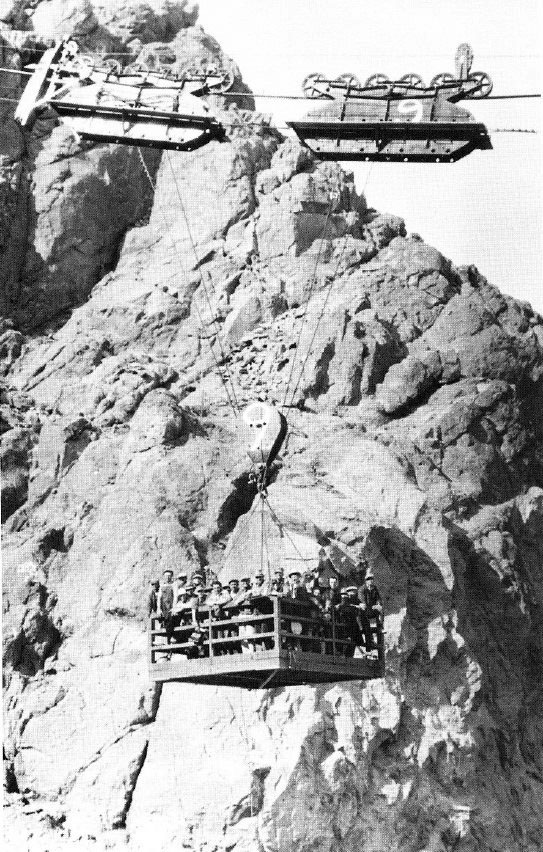 |
(1932)^^# – Cableway lowered men and equipment into Black Canyon to work on the dam.
|
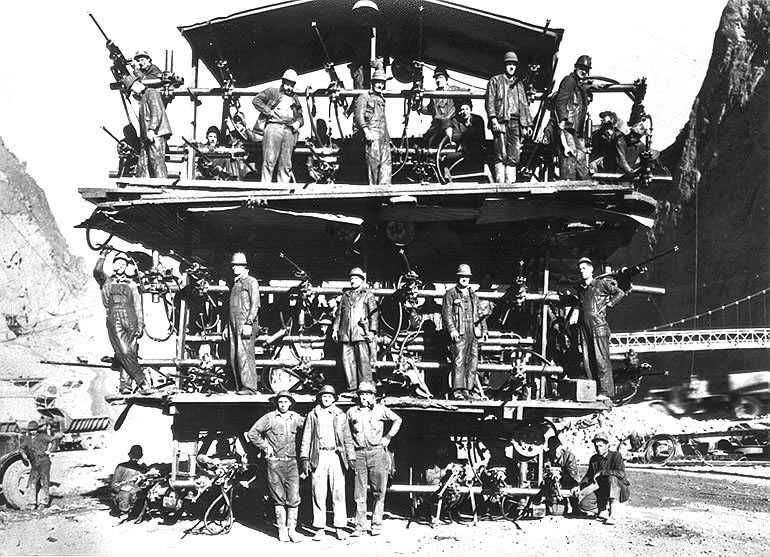 |
|
| (ca. 1932)^ - Workers on a "Jumbo Rig" that was used for drilling Hoover Dam's tunnels. |
Historical Notes The Jumbo Rig was designed to speed up the Hoover Dam's tunnel drilling process. Built on the back of a 10-ton truck, 24 to 30 drills could be operated at once.^ These jumbos had two platforms for drillers to stand on, the third level of men working from the ground. It also had horizontal bars at the three levels, where the pneumatic drills hung by swivels. The process then became: Back the truck up to the solid rock wall, drill the holes, pack them with dynamite, tie them together and then pull the entire truck a safe distance away while the blowman detonated. Then clear away the debris and do it again.*#* |
 |
|
| (1932)**^ – View showing the interior of one of the tunnels through which the Colorado River will be diverted around the Hoover Dam site., April 18, 1932. |
(1932)^^# – Penstock pipe sections were lowered into the canyon by a 150-ton capacity cableway, then carried in the tunnels on railroad cars.
|
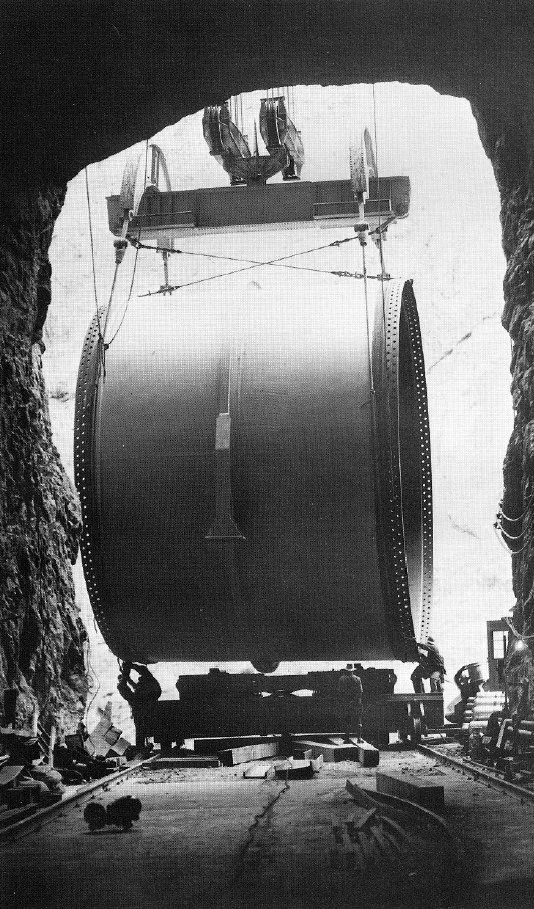 |
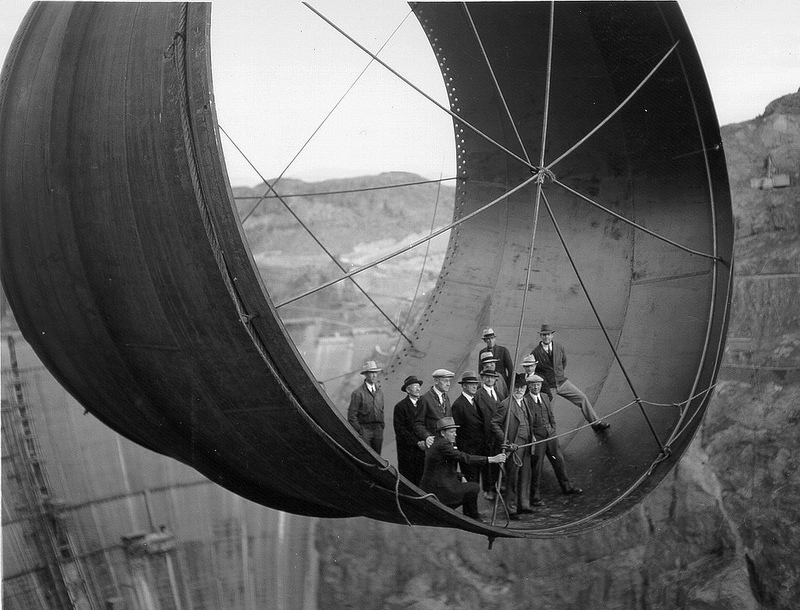 |
|
| (ca. 1933)^#^ - Government officials and politicians take a ride in one of the 30 ft. diameter pipe sections. |
Historical Notes Forty-four thousand tons of steel were formed and welded into 14,800 feet of pipe varying from 8 1/2 to 30 feet in diameter. Each length of the largest pipe - 12 feet long, 30 feet in diameter, and 2 3/4 inches thick - was made from 3 steel plates, of such weight that only two plates could be shipped from the steel mill to the fabricating plant on one railroad car. Two such lengths of pipe welded together make one section weighing approximately 135 tons or, at intersections with the penstocks, as much as 186 tons.^*^ |
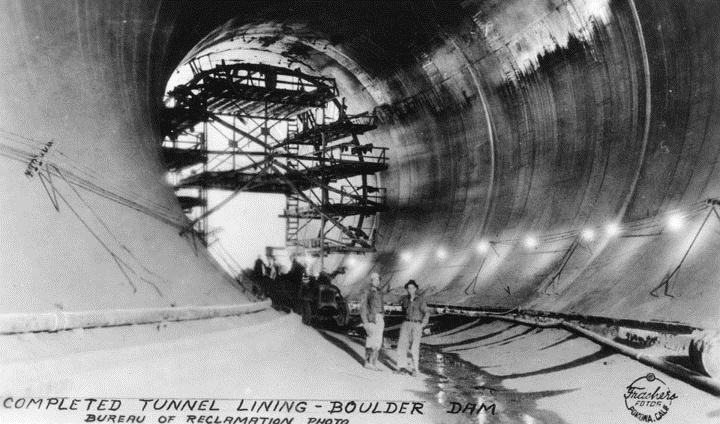 |
|
| Workmen stand in completed spillway tunnel lining at Boulder Dam.* The spillway tunnel is 50 feet in diameter and 2,200 feet in length. Click HERE to view a detail diagram showing Boulder Dam's piping and penstock configuration. |
Historical Notes Each of the 4 diversion tunnels was holed out to 56-foot diameter—as high as a 4-story building—and lined with a 3-foot thickness of concrete. The total length of the tunnels was approximately 3 miles.**# |
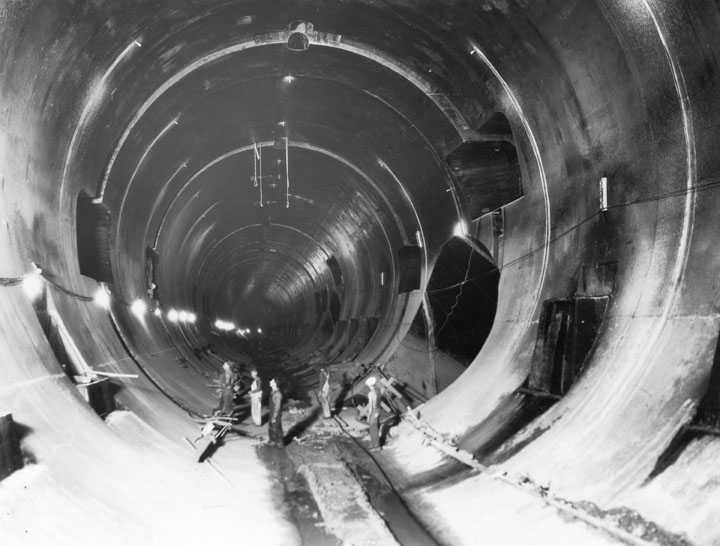 |
|
| (1934)* - Five workmen peer at the inside one of the four diversion tunnels. Behind them on the right is another tunnel. |
Historical Notes The four tunnels would have another important use besides diversion of the river. After completion of the dam, they would serve to house the outlet works used in the regulation of the reservoir. The two outer tunnels would become outlets for the huge spillways. The two inner tunnels would guide the stored water from the intake towers in the reservoir to the power plant or past it to the outlet valves below the dam.**# |
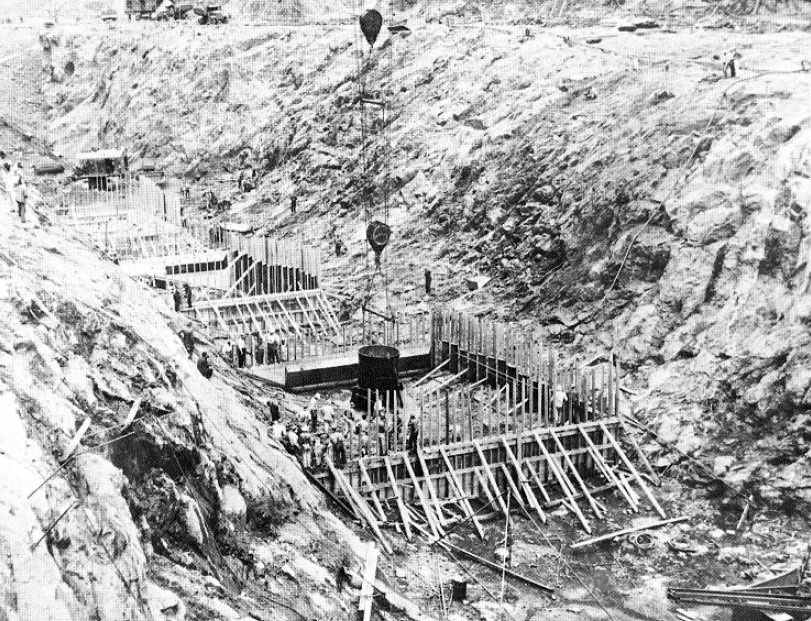 |
|
| (1933)^^# - The first bucket of concrete for Hoover Dam was placed June 6, 1933. |
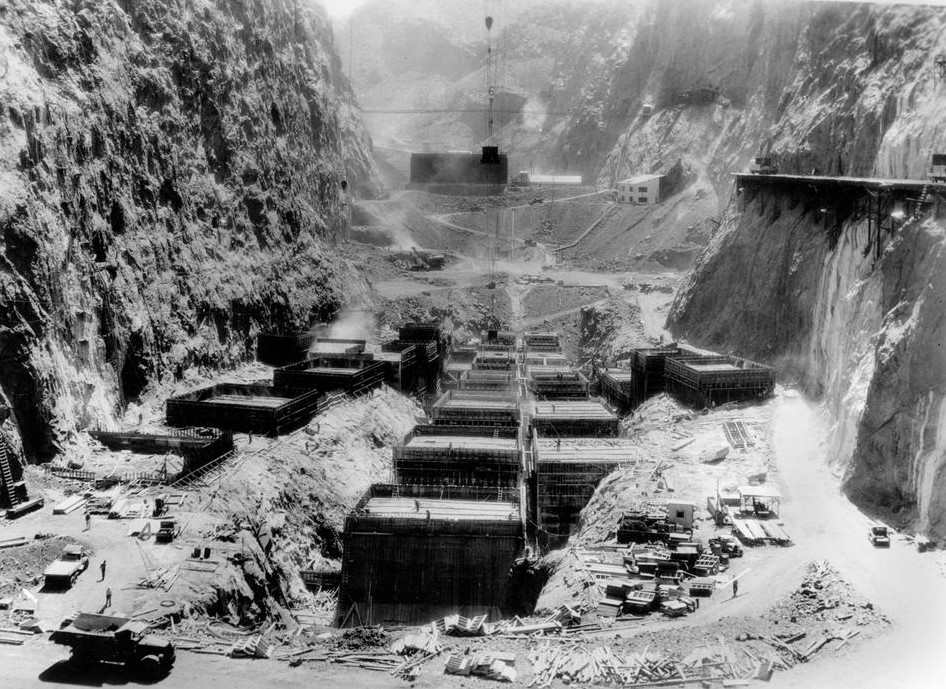 |
|
| (1933)**^ – Downstream view of the Hoover Dam showing the immense concrete blocks rising from the bedrock of Black Canyon's floor, which will be the core of the dam, Aug. 12, 1933. Concrete is being poured into the forms at the rate of about 6,000 cubic yards daily. |
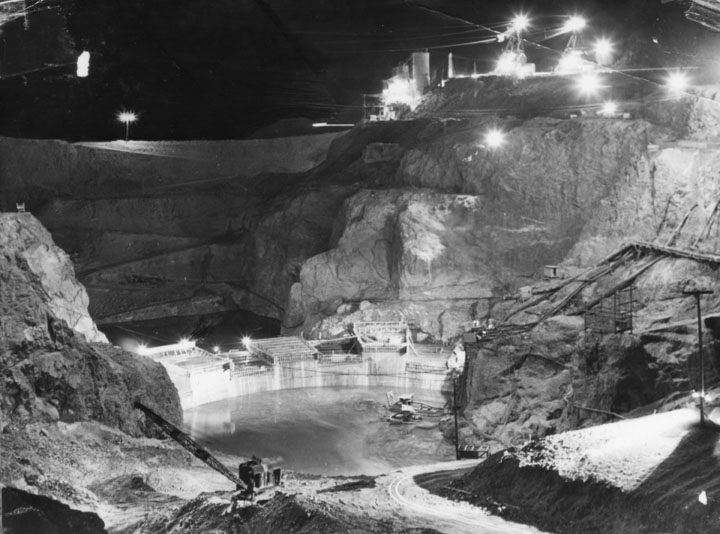 |
|
| (ca. 1933)^^ - Construction was a 24/7 operation. In this view we can see the base of the dam face on the far side of a pool of water, construction equipment and night lights. |
Historical Notes The first concrete was poured into the dam on June 6, 1933, 18 months ahead of schedule.^ |
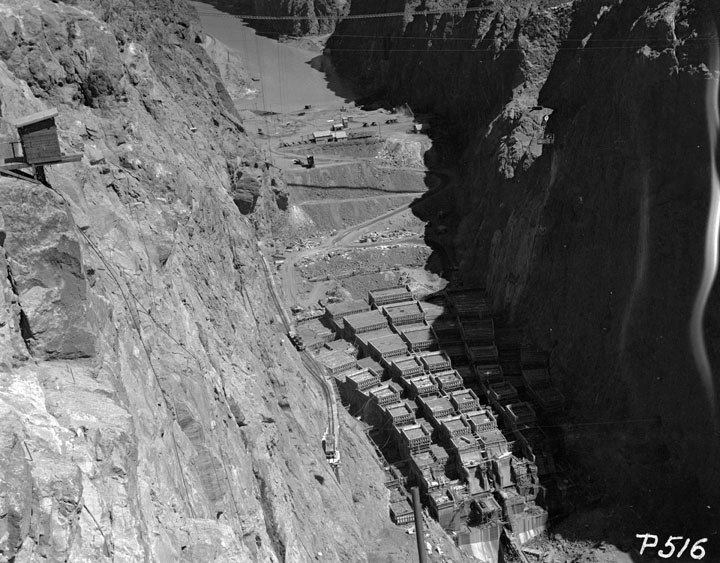 |
|
| (ca. 1933)* - Hoover Dam initial construction phase. Note the width and depth of the dam as it goes up. |
Historical Notes Since concrete heats and contracts as it cures, the potential for uneven cooling and contraction of the concrete posed a serious problem. Bureau of Reclamation engineers calculated that if the dam was built in a single continuous pour, the concrete would take 125 years to cool and the resulting stresses would cause the dam to crack and crumble. Instead, the ground where the dam was to rise was marked with rectangles, and concrete blocks in columns were poured, some as large as 50 feet square and 5 feet high.^ |
 |
|
| (ca. 1933)* - View of the on-site cement plant at Hoover Dam. |
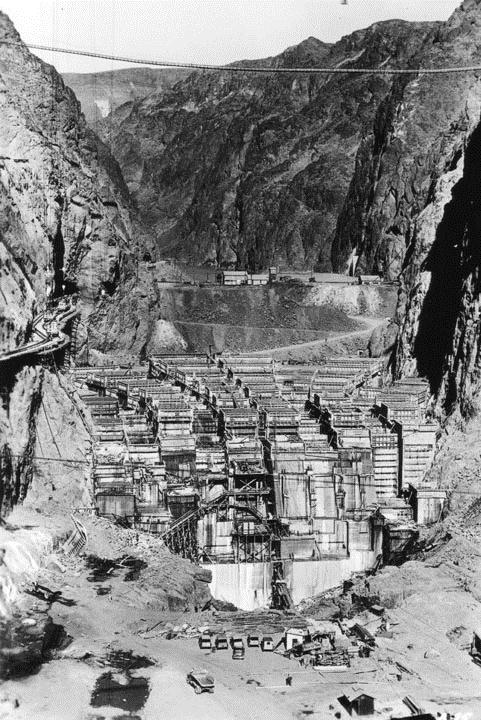 |
|
| (1934)* - Wooden forms seen above the dam. The fleet of trucks used to haul materials for the concrete are seen in foreground. |
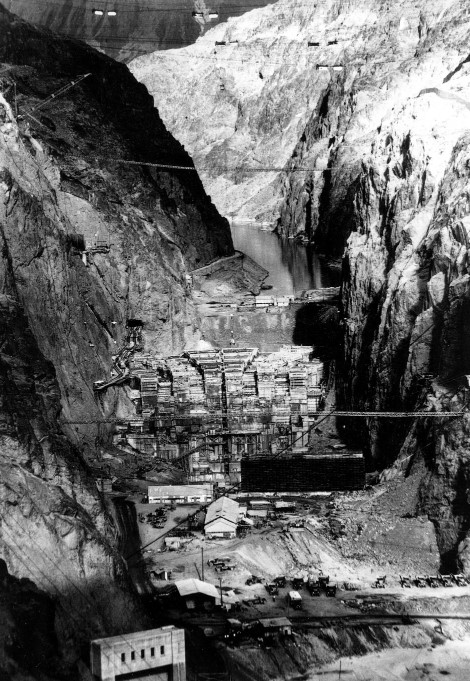 |
|
| (1934)**^ – Aerial view looking upstream through the Black Canyon, shows the giant concrete forms covering the finished base of the Hoover Dam. |
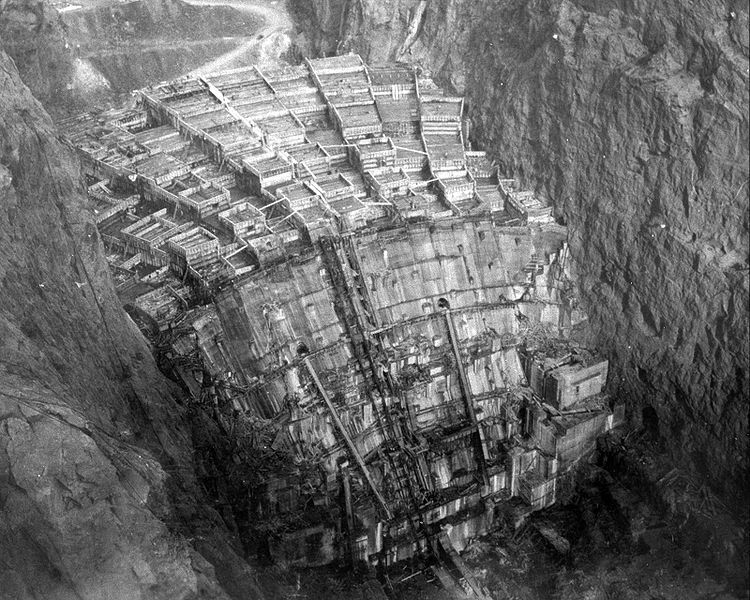 |
|
| (1934)^ - Hoover Dam takes shape from the concrete columns in which it was poured. |
Historical Notes Each five-foot form contained a series of 1 inch steel pipes through which first cool river water, then ice-cold water from a refrigeration plant was run. Once an individual block had cured and had stopped contracting, the pipes were filled with grout. Grout was also used to fill the hairline spaces between columns, which were grooved to increase the strength of the joins.^ |
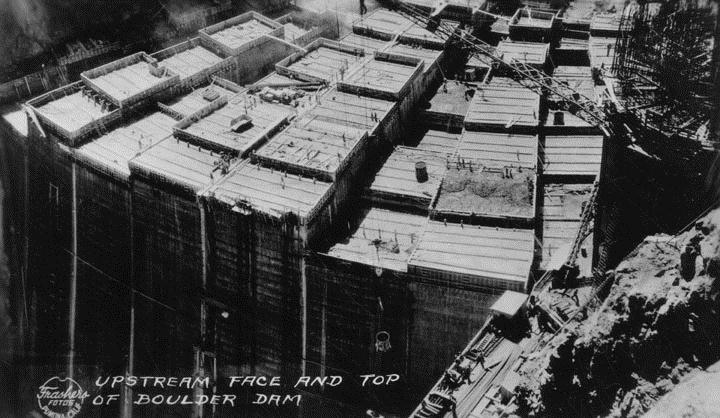 |
|
| (ca. 1934)* - Upstream face and top of Boulder Dam. |
Before and After
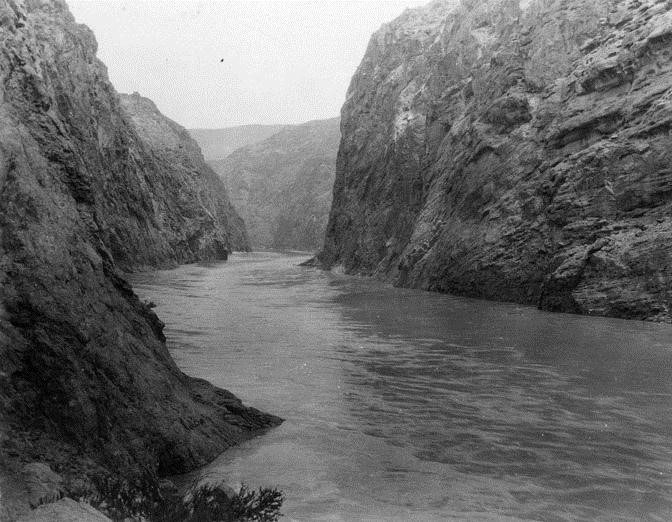 |
 |
||
| (1930)* | (1934)^ |
Hoover Dam Construction Time Lapse Video
Click HERE to see 30 seconds time lapse video. |
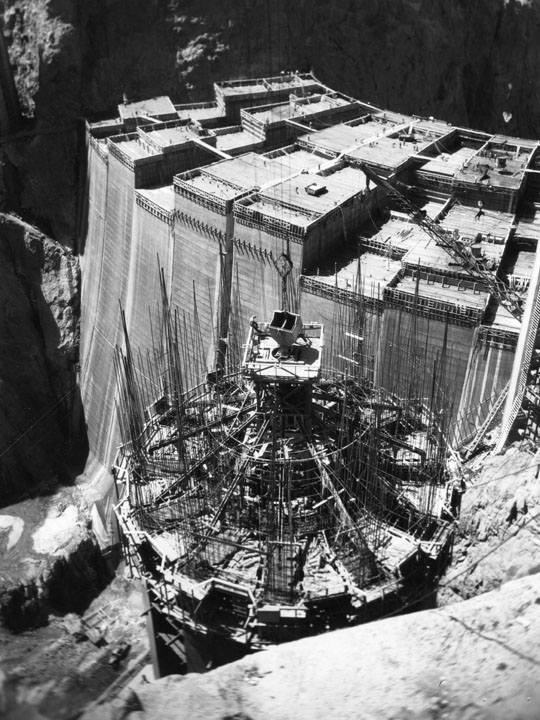 |
|
| (1934)^^ - Looking down at the construction of one of the Nevada intake towers. These towers permit and control flow of water into tunnels and then to power turbines. |
 |
|
| (1934)#* - A raised view of the Hoover dam while it was under construction. Most of the concrete has already been poured, and work seems to be concentrated on the top and at the base of the dam. |
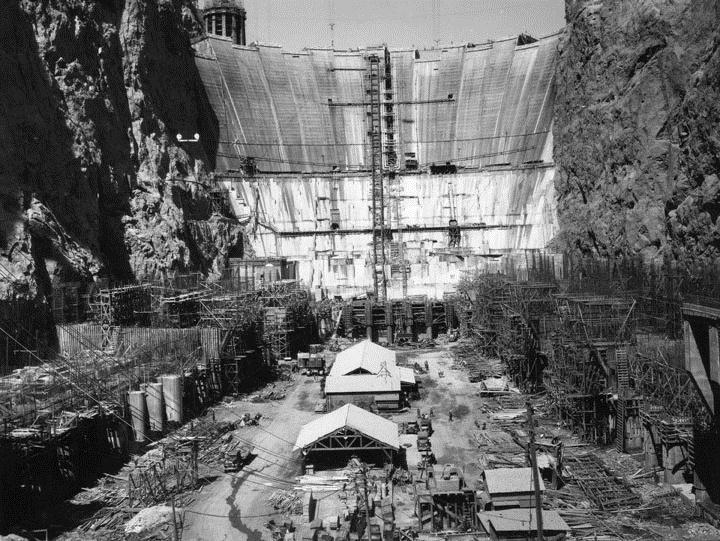 |
|
| (ca. 1934)* - The cement forms for the two power plants can clearly be seen. |
Historical Notes Every state in the USA furnished supplies and materials for the construction of the dam. #* |
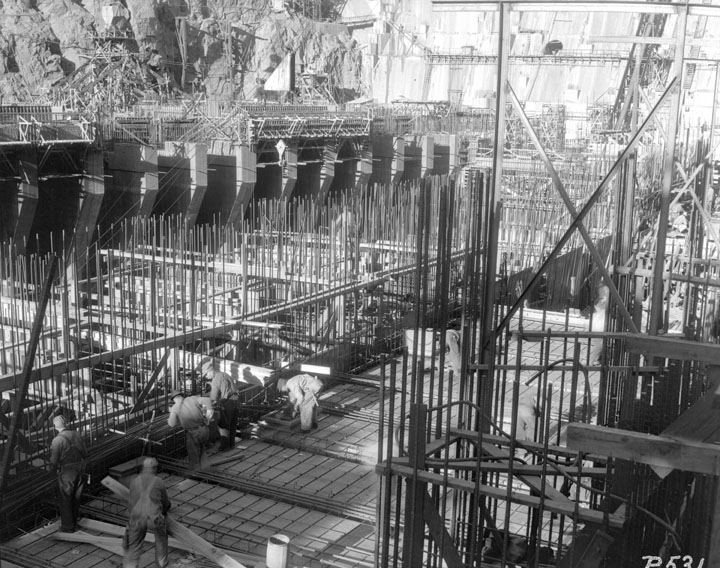 |
|
| (ca. 1934)* - A closer look at the cement forms for the two power plants. Construction workers can be seen throughout. |
Historical Notes There were 112 deaths associated with the construction of the dam. Included in that total was J. G. Tierney, a surveyor who drowned on December 20, 1922, while looking for an ideal spot for the dam. He is generally counted as the first man to die in the construction of Hoover Dam. His son, Patrick W. Tierney, was the last man to die working on the dam's construction, 13 years to the day later. Ninety-six of the deaths occurred during construction at the site of the 112 fatalities^.... None were buried in the concrete. #* |
.jpg) |
(1934)#* - View of three men standing by a Packard observing the near completed process of concrete pouring at the dam.
|
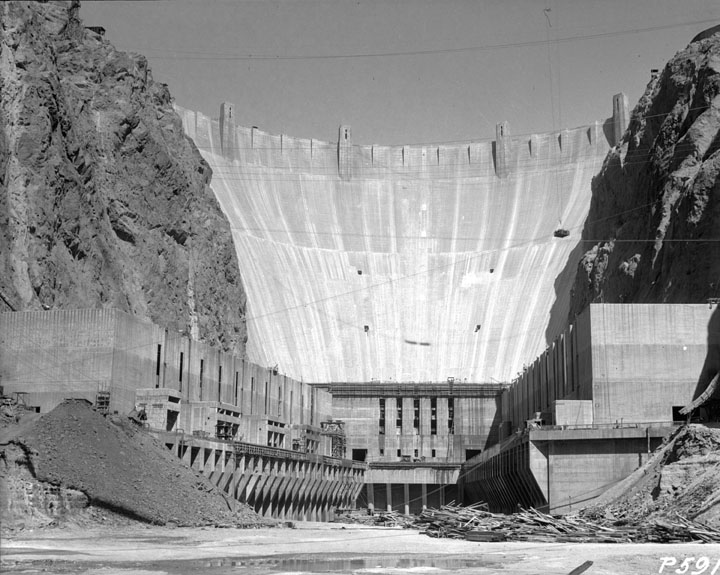 |
|
| (1935)* - View of the Hoover Dam power plants near completion. The concrete pouring process appears to be complete. |
Historical Notes A total of 3,250,000 cubic yards of concrete was used in the dam before concrete pouring ceased on May 29, 1935. In addition, 1,110,000 cubic yards were used in the power plant and other works. More than 582 miles of cooling pipes were placed within the concrete. Overall, there is enough concrete in the dam to pave a two-lane highway from San Francisco to New York.^ |
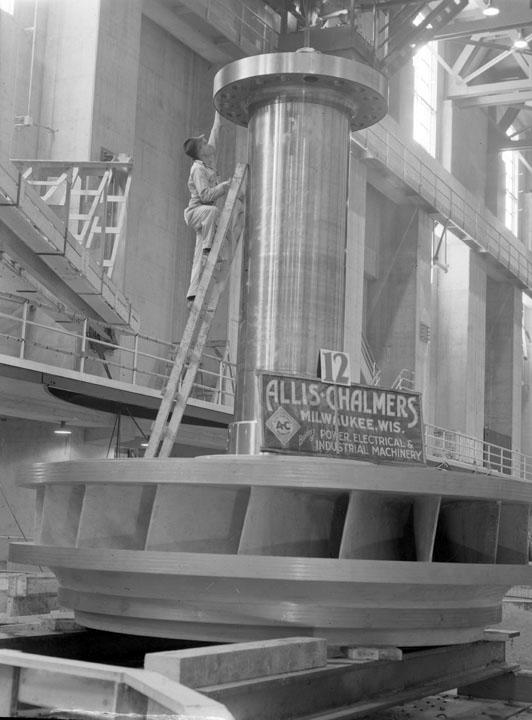 |
(ca. 1935)* - View of the giant turbine runner before its installation at Hoover Dam power plant. The fin-like pieces of metal between the two circular flanges are the vanes.
|
Historical Notes The powerplant consists of 17 main Francis turbine generators and two Pelton Waterwheel station service units (one for each plant wing). The total plant capacity is 2,079 MW.*#^ |
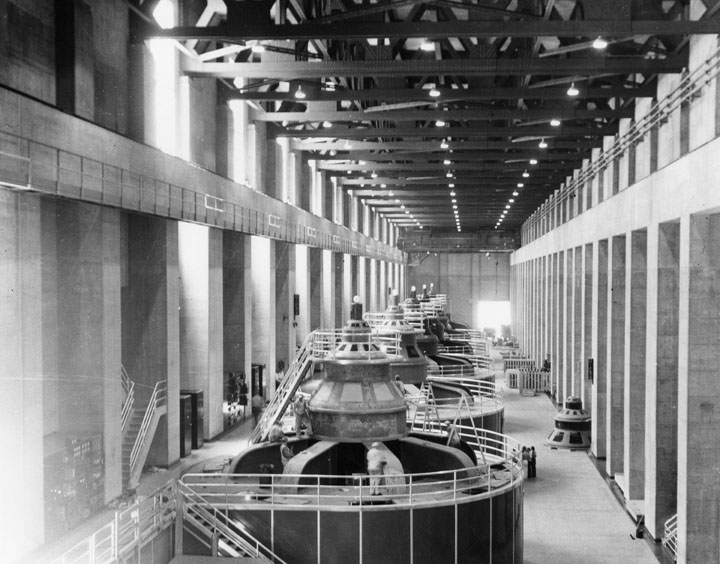 |
|
| (ca. 1936)* - View of the upper generator room at Hoover Dam, on the Nevada side, where there are eight generators. (The Arizona side has nine.) |
Historical Notes Each generator weighs 4 million pounds, as much as 4 1/2 fully loaded Boeing 747-400's. #* |
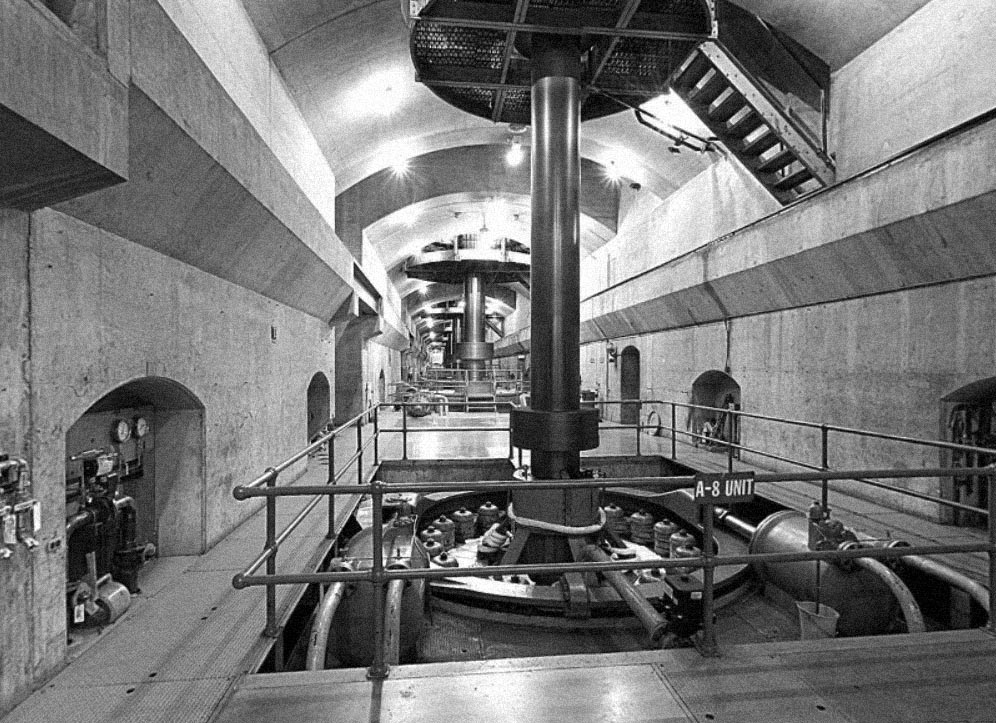 |
|
| (n.d.)#+ - View of the lower level showing the shafts that connect the turbines (below) to generators (above). |
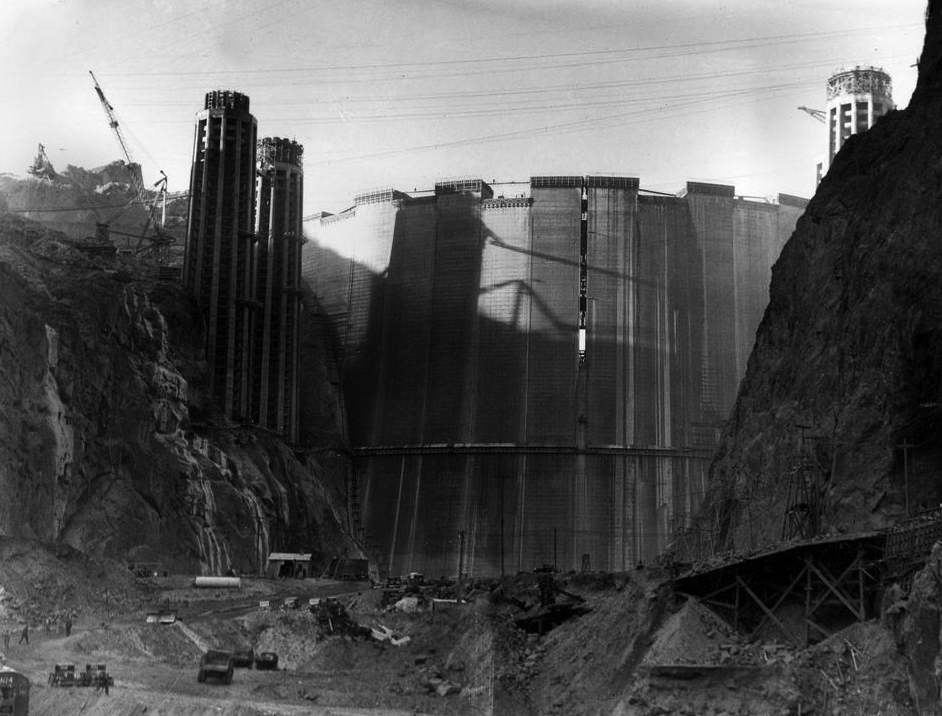 |
|
| (1935)**^ – This is a view of the Hoover Dam from upstream as construction continued near Boulder City, Nev., Feb. 1, 1935. The crack in the upper center of the dam is a space left open for cooling and settling of the concrete and will be filled as work progresses. |
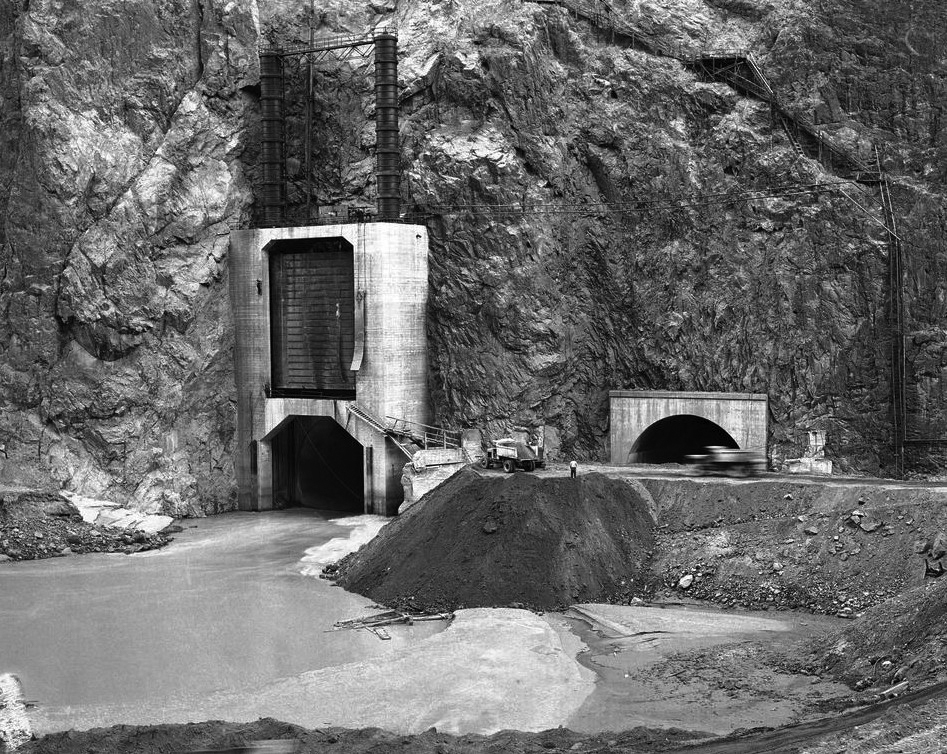 |
|
| (1935)**^ – A three million pound gate of tunnel no. 4, shown above at left, was ready to close, Feb. 1, 1935, stopping flow of the Colorado River at the Boulder Dam, thus starting filling of a huge reservoir. The above photo taken just before the gate started closing shows a coffer dam built across the entrance of tunnel no. 3, which has been diverting the river through the canyon walls and around the dam on the Arizona side. |
 |
|
| (1935)* - Hoover Dam close to completion. Water can already be seen at the base of the dam. |
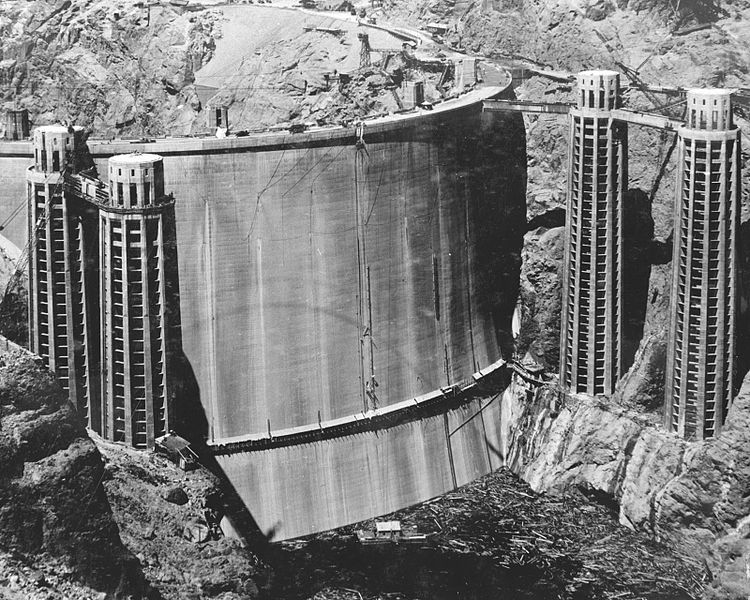 |
|
| (1935)^ - The upstream face of Hoover Dam slowly disappears as Lake Mead fills. |
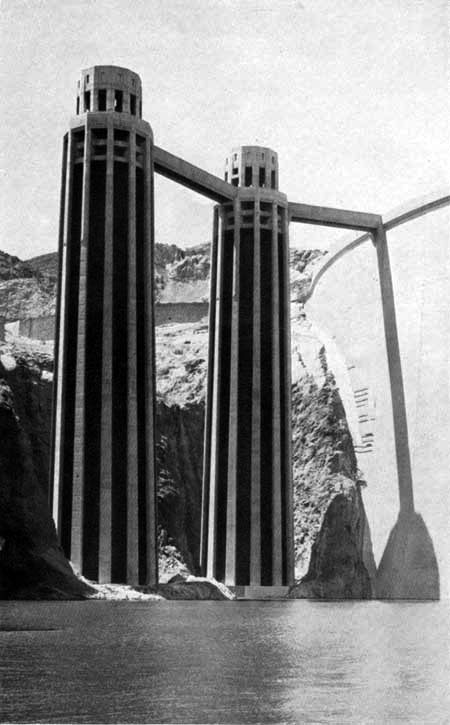 |
(1935)**# - View of the graceful intake towers whose gates control the release of the reservoir water.
|
|
Historical Notes When the newly formed Lake Mead had risen to the base of the intake towers, 260 feet above the river bed, the one remaining opening—the slide gates in the Nevada outer diversion tunnel plug—was closed to the Colorado. From that time on the river had to respond to rein. The broncho of the West was fully harnessed.**# |
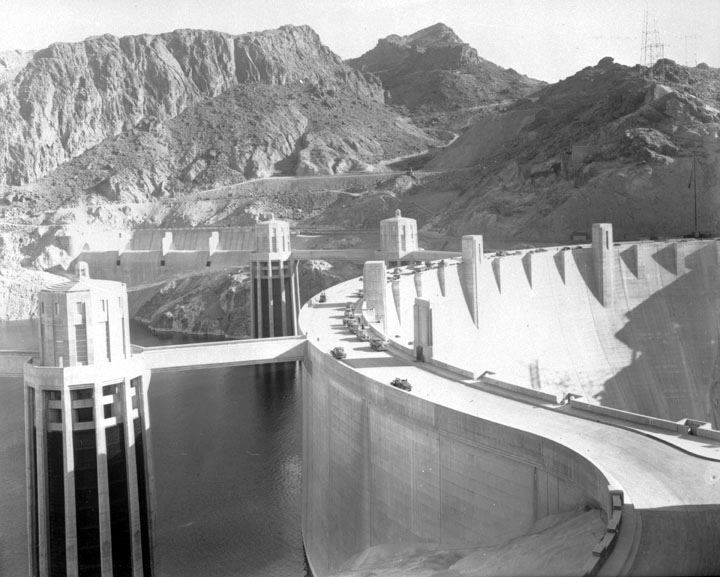 |
|
| (ca. 1935)* - View of the intakes as the water level nears the top of Hoover Dam. Cars are parked along the roadway over the dam. The Arizona Spillway can be seen on the other side of the canyon. |
 |
|
| (1935)^#* - View of Hoover Dam as seen from above the Arizona Spillway side looking toward the intake towers as the water continues to rise. |
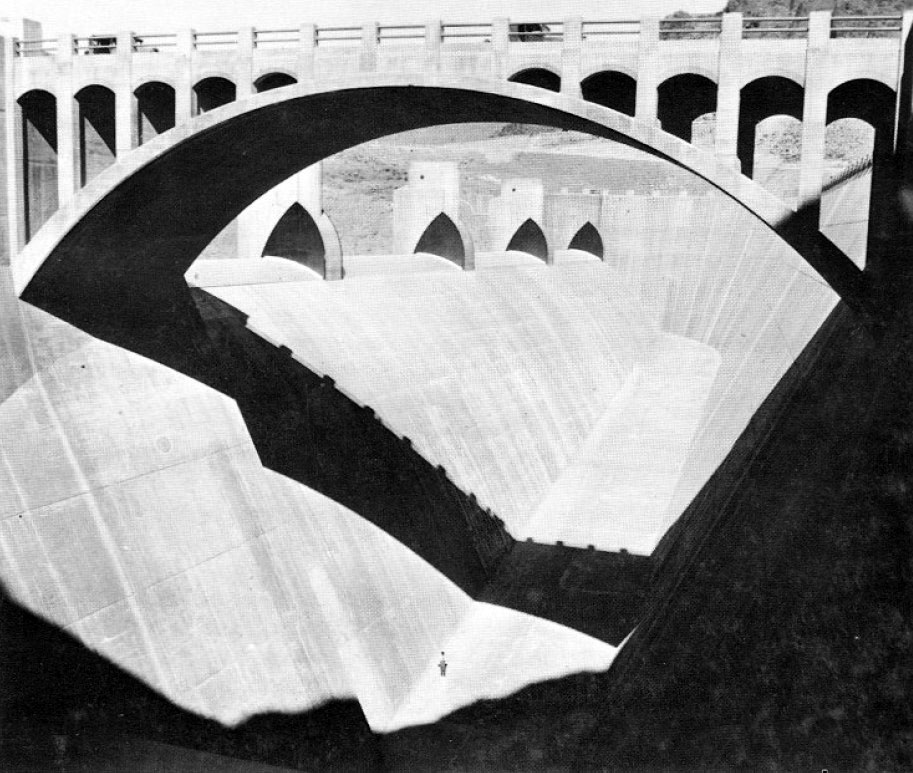 |
|
| (1936)^^# – View showing the Arizona Spillway. It is 650 feet long, 150 feet wide, and 170 feet deep. Note the man at bottom of spillway. |
Historical Notes If the spillways were operated at full capacity, the water flow would be about the same as the flow over Niagara Falls (for each spillway).^^# |
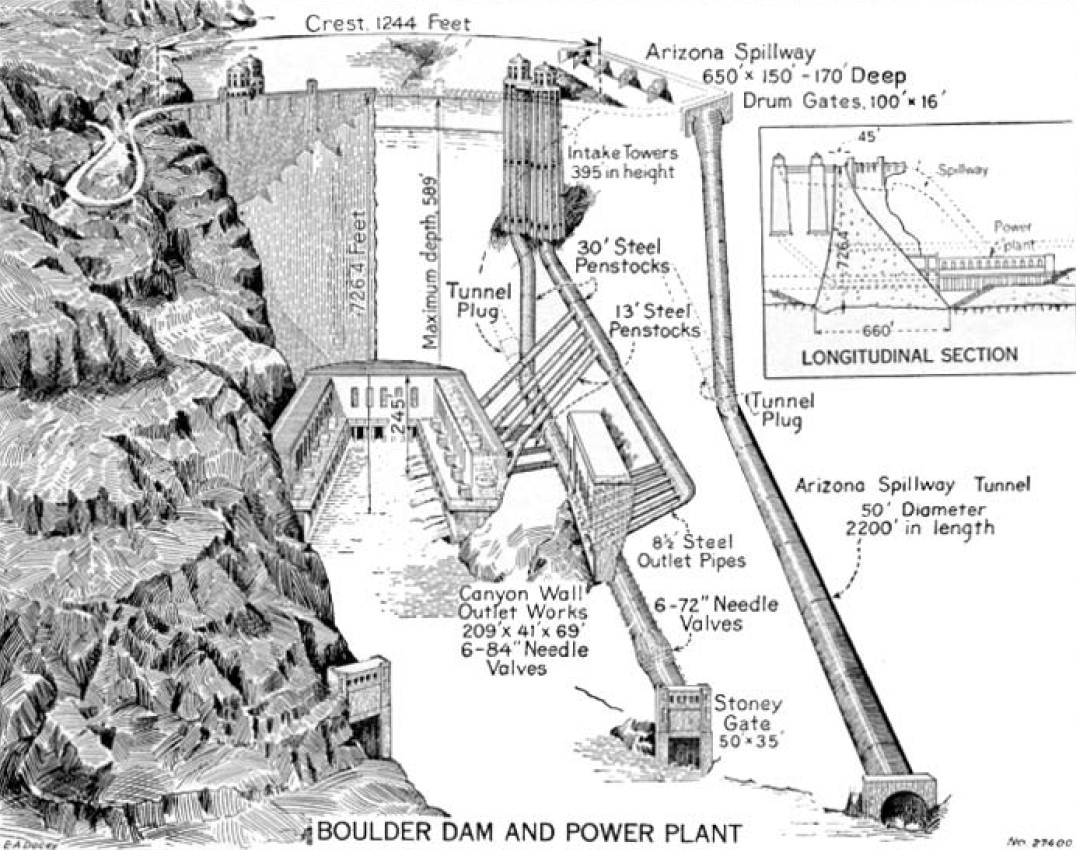 |
|
| (n.d.)**# – Detailed drawing of the dam and power plant from U.S. Department of Interior. |
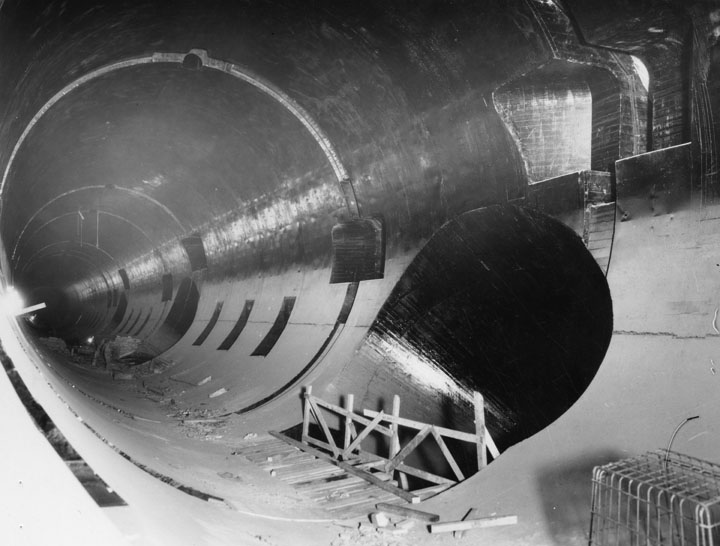 |
|
| (1934)* - View of the diversion tunnel, showing the entrance of one of the 16 tunnels which lead to the turbines. The water will then turn turbine generators to create the electricity. |
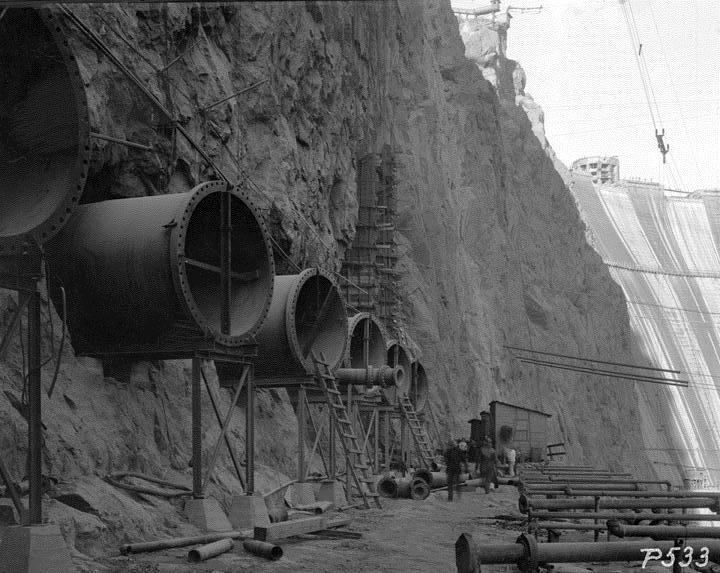 |
|
| (ca. 1934)* - The needle valves of the power plant under construction. The valves are 13 feet in diameter and will dicharge the water back into the Colorado River once the water does its work by turning the turbine generators. |
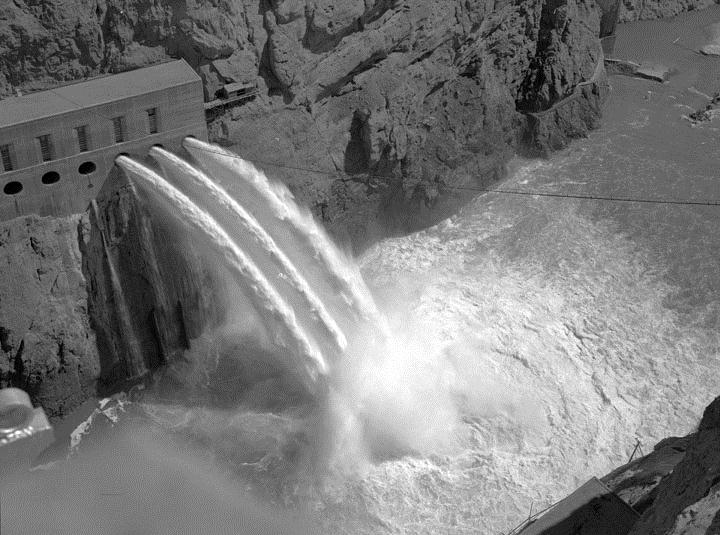 |
|
| (1936)* - Hoover Dam during the final stages of testing. Three of the 13 foot diameter penstocks are fully opened. |
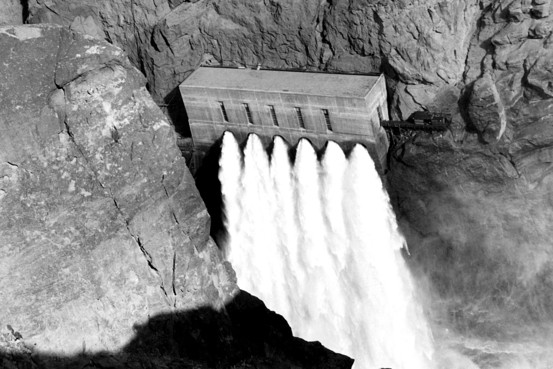 |
|
| (1936)** - Another view of the final testing showing water flowing out of all six of the penstocks on one side of the dam. |
Historical Notes During peak electricity periods, enough water runs through the generators to fill 15 average sized swimming pools (20,000 gallons each) in 1 second. #* |
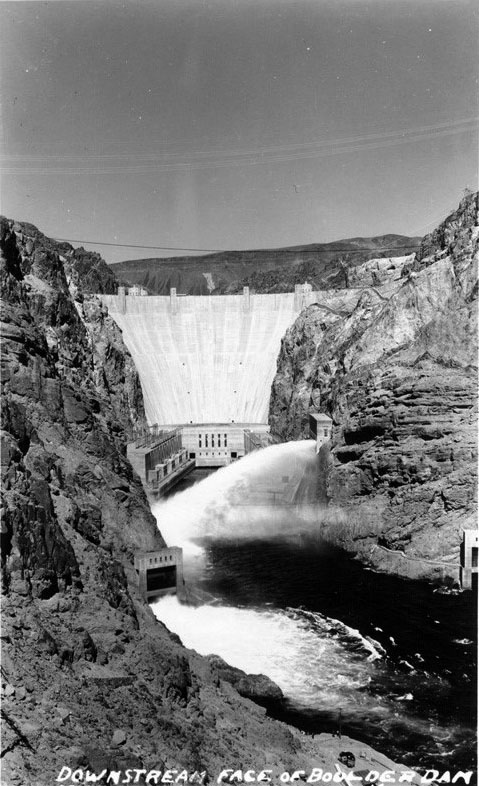 |
(1936)^* - View of the face of Boulder Dam from downstream during testing of the turbine-generators. |
 |
|
| (1936)**^ – Aerial view showing Hoover Dam and a portion of Mead Lake. Water flows from the lake at the ratio of several thousand gallons per second from outlet valves on the Arizona side, below dam. |
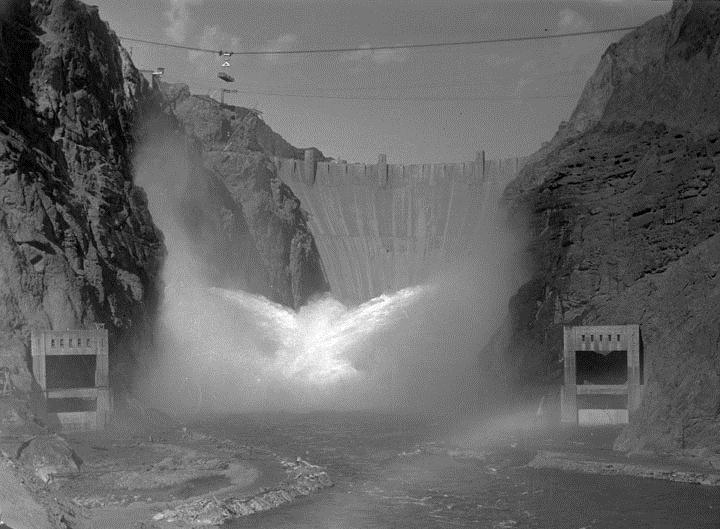 |
|
| (1936)* - View of the first time 12 valves in canyon wall outlet works were simultaneously discharging Colorado River water. In the future the valves will be used only in emergencies, the tremendous power of the falling waters being carried by huge steel penstocks to turn the turbine wheels of fifteen 115,000 horsepower generators such as those shown in inset. On October 9 the second generator in this row flashed to Los Angeles the Power Bureau’s first allotment of Boulder power.*^ |
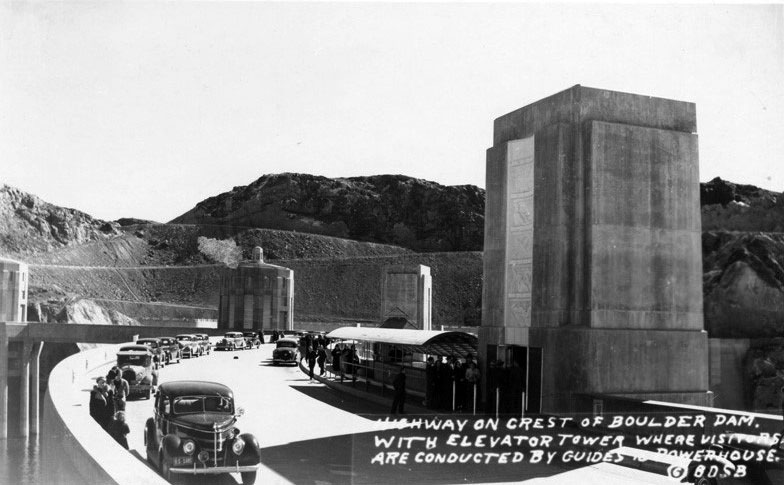 |
|
| (ca. 1938)^* - Postcard view of the highway on the crest of Boulder Dam, showing the elevator tower where visitors are conducted by guides to the powerhouse. |
 |
|
| (ca. 1938)^^# – Aerial view showing a completed Hoover Dam with Lake Mead filled to capacity behind it. |
Historical Notes Hoover Dam, one of the world’s outstanding engineering achievements, was selected by the American Society of Civil Engineers in 1955 as one of America’s seven modern civil engineering wonders. Majestic in its clean graceful lines, the dam stands with one shoulder against the Nevada wall and the other against the Arizona wall of Black Canyon, harnessing the Colorado River.^^# |
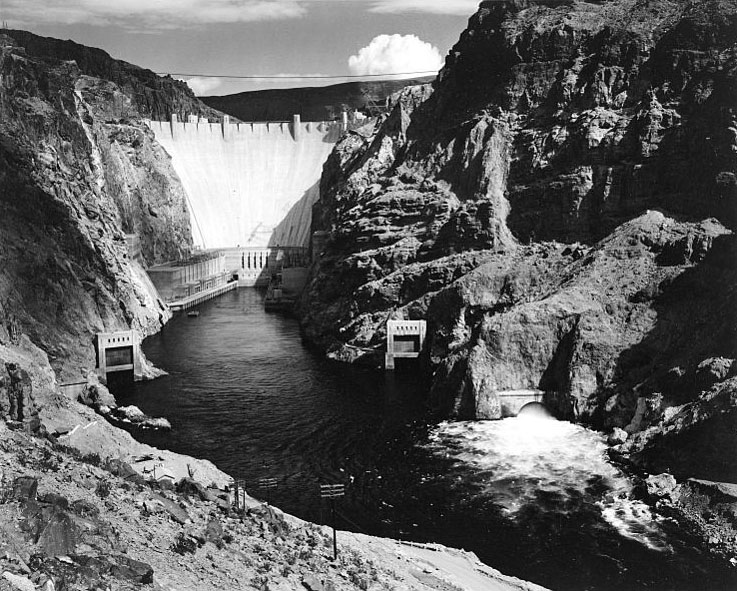 |
|
| (1942)^^ - A photo of Hoover Dam by Ansel Adams. |
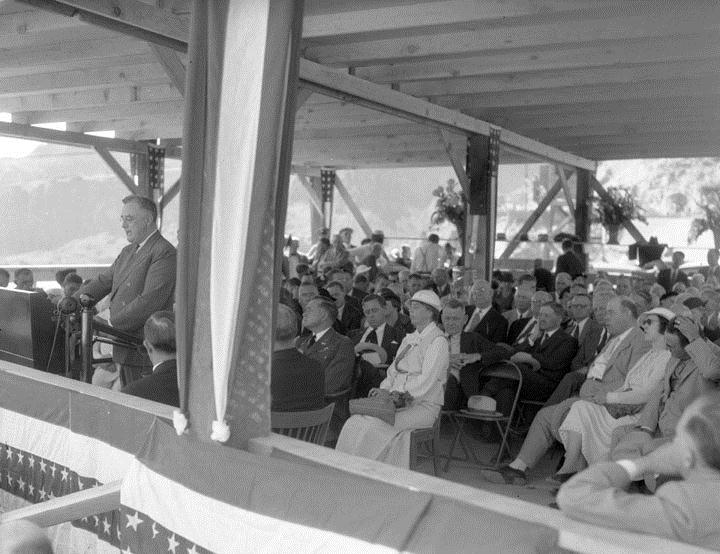 |
|
| (September 30, 1935)* - Dedication of Hoover Dam by President F. D. Roosevelt. Ezra Scattergood can be seen in the lower right behind the chair with the hat. |
Historical Notes On September 30, 1935, less than 5 years after construction started, President Franklin D. Roosevelt said in dedication ceremonies at Hoover Dam: “This is an engineering victory of the first order – another great achievement of American resourcefulness, skill and determination. This is why I congratulate you who have created Boulder Dam and on behalf of the Nation say to you, ‘well done’.” ^## In 1920, Ezra Scattergood pushed for a bill authorizing the construction of the Boulder Canyon Project (Hoover Dam). Despite attempts to discredit the project, Scattergood helped convince Congress in 1928 to pass the legislation and allow construction of the dam and a hydroelectric power plant.^# |
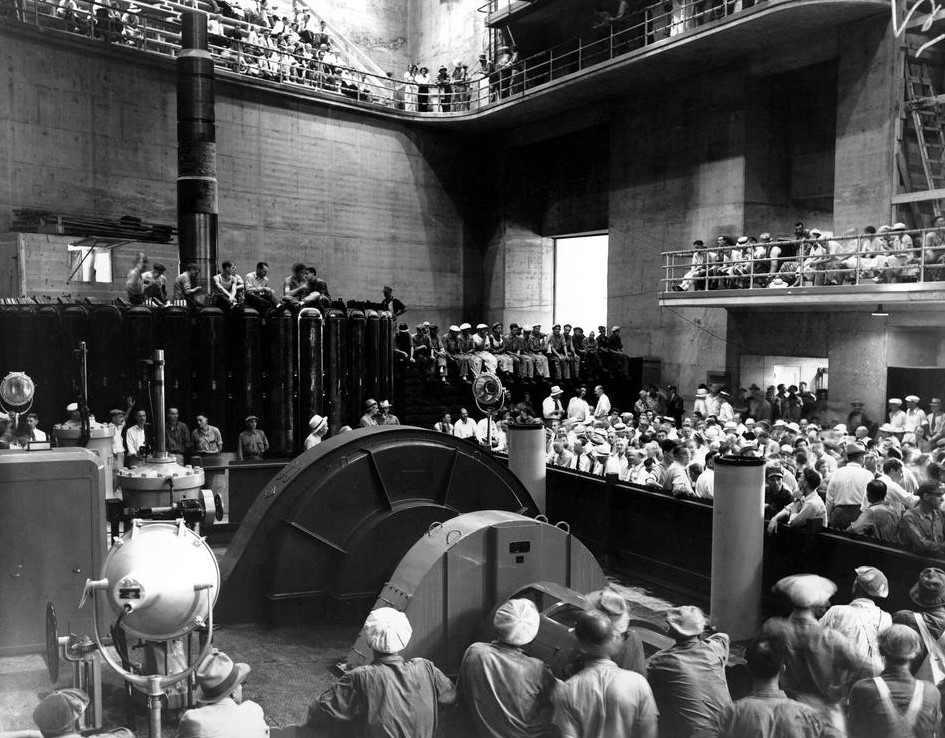 |
|
| (1936)**^ – A crowd is assembled in the power house of the Hoover Dam in Boulder City, Nev., during ceremonies in which U.S. President Franklin Roosevelt pressed a button in Washington, D.C., starting the 3,500 horsepower generator in the foreground, creating the first power from the dam in Boulder City, September 11, 1936. |
Historical Notes The City of Los Angeles would have to wait another 28 days (October 9th, 1936) before it would get its allotment of power from Hoover Dam. |
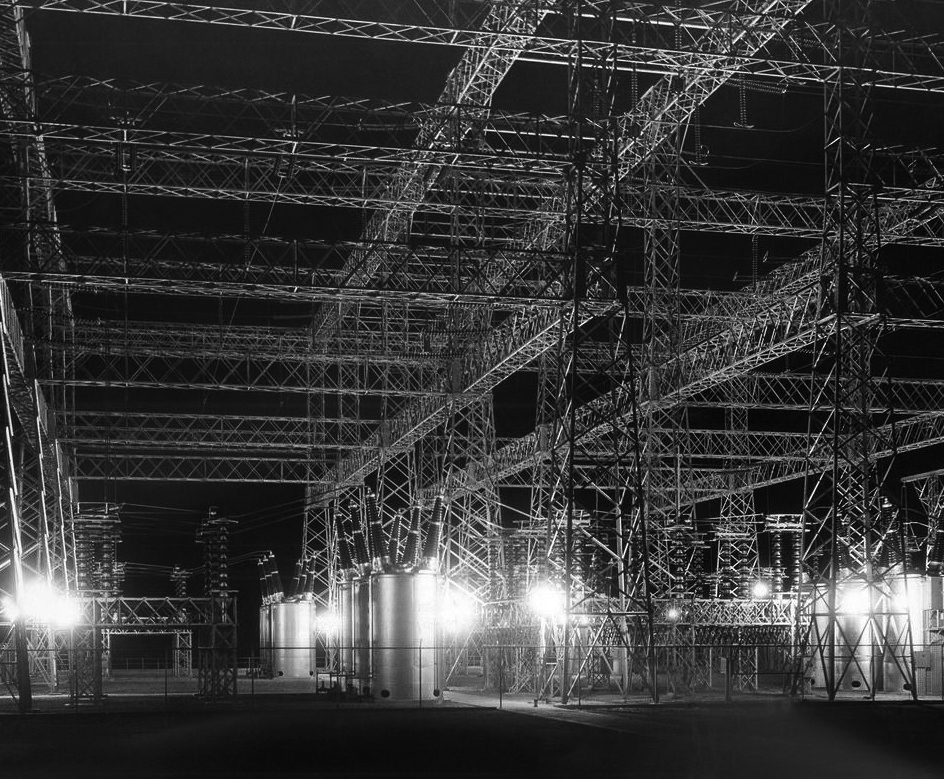 |
|
| (1930s)**^ – View showing the high-voltage switching yard at Boulder Dam, with the steel etched against a black desert sky. Power from the generators at the top of Boulder Dam left this station on the main line to Los Angeles at 287,500 volts. |
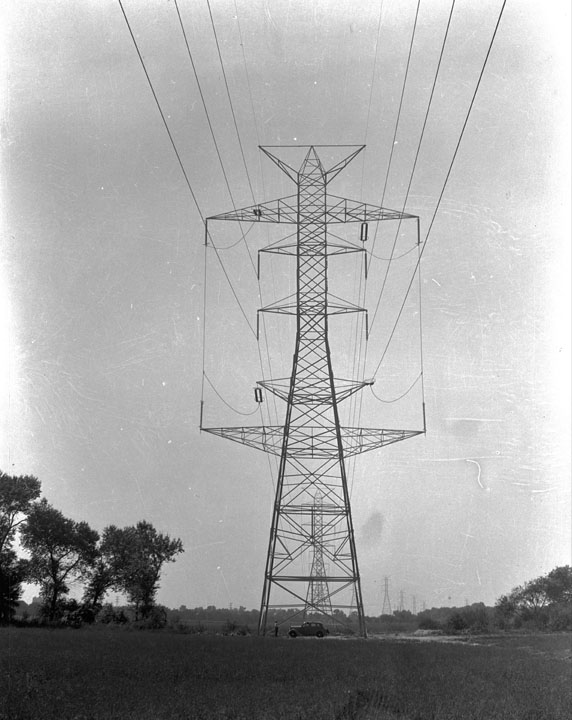 |
|
| (1935)* - Double-circuit tower carrying 287,000 volt lines from Boulder Dam to Los Angeles. |
Historical Notes Sixteen high-voltage transmission lines connect Hoover Dam with its power market area. Two lines terminate at Los Angeles, a line a distance of 266 miles. A third line extends to Los Angeles via the McCullough Switching Station, where the energy is stepped up to 500,000 volts. One line extends to San Bernardino, California. Three lines extend to Las Vegas, Nevada. One of the latter connects with the Davis Dam transmission system. Other lines extend to Kingman, Arizona; Needles, California and nearby Boulder City.^^# In total, there are 2700 miles of transmission line cable sending electricity from Hoover Dam to Los Angeles. #* Click HERE to see more in Early Power Transmission. |
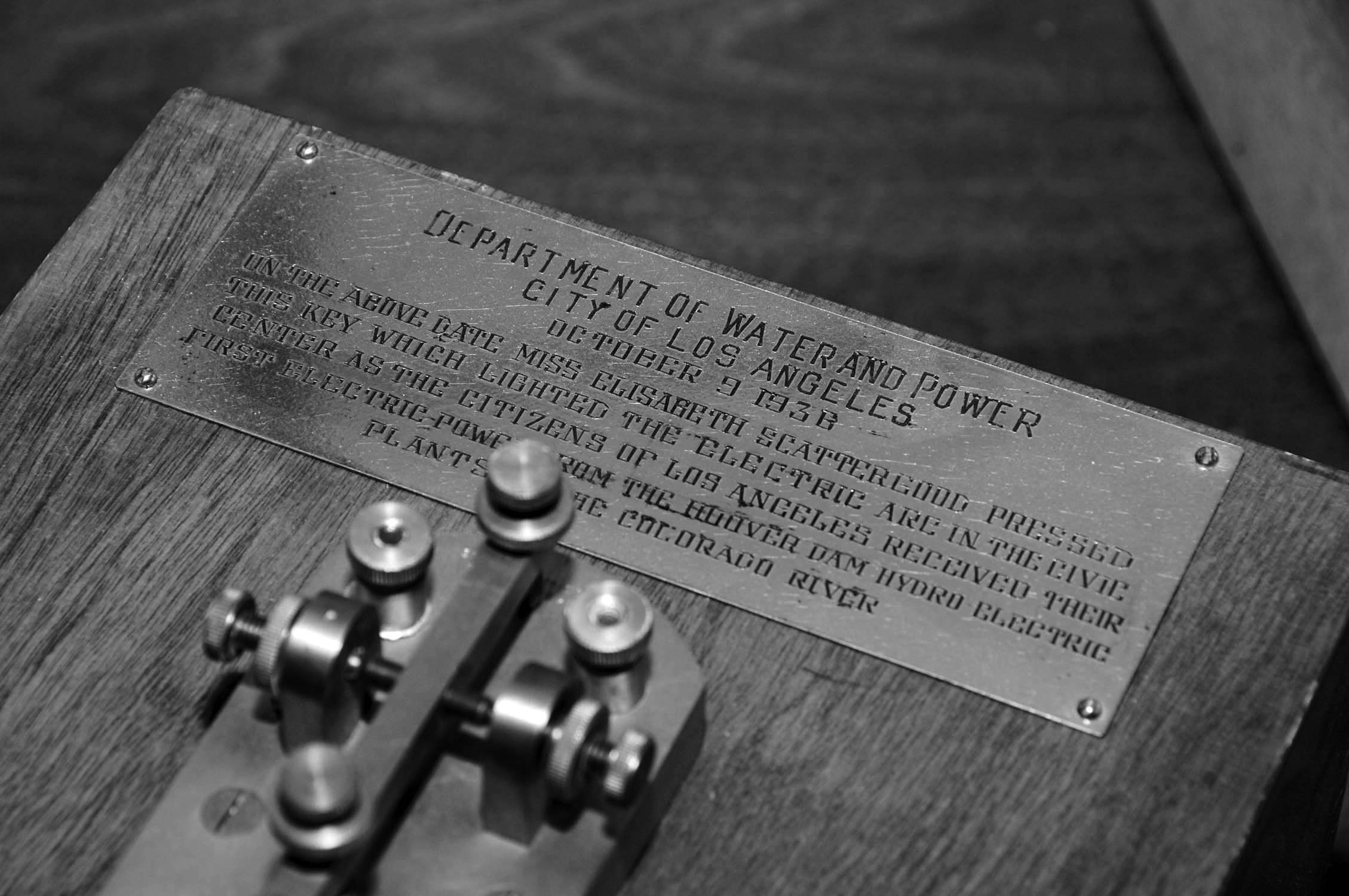 |
|
| (October 9, 1936) - Plaque reads: "On the above date Miss Elisabeth Scattergood pressed this key which lighted the electric arc in the Civic Center as the citizens of Los Angeles received their first electric power from the Hoover Dam Hydro Electric Plants of the Colorado River". |
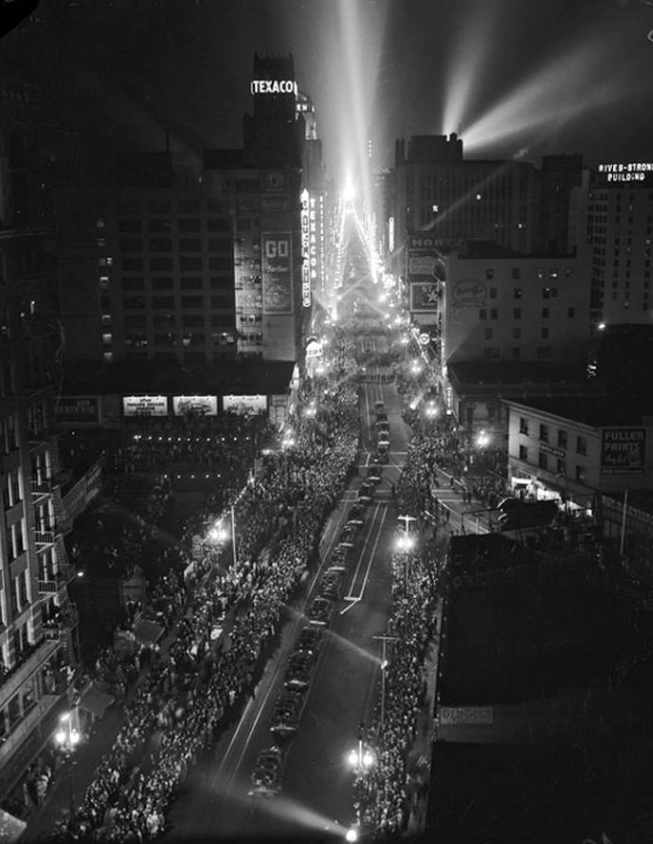 |
|
| (1936)* - Tens of thousands of people jammed the parade route on Broadway on the night of October 9, 1936, as the street became ablaze with light when the first Hoover power streaked 266 miles from the power plant to Los Angeles. |
Construction of Hoover Dam Video
Click HERE to view video. |
Construction of Hoover Dam - Historical TimelineThe following timeline takes us from the late 1890’s when the first attempt to control flooding from the Colorado River began to 1936 when the Hoover Dam was completed and electric power flowed to the City of Los Angeles: |
1890’s – Initial attempt at diverting the Colorado River for irrigation purposes by the construction of the Alamo Canal by land speculator William Beatty. 1900 – Preliminary investigation and studies for building a dam at Black Canyon or Boulder Canyon with the purpose of controlling floods, providing irrigation water, and producing hydroelectric power. Repeated flooding of the Imperial Valley and other areas created the need to control the Colorado River through construction of a dam. 1902 – Edison Electric Company surveys the Colorado River with the idea of building a 40-foot rock dam which could generate 10,000 horsepower. At this time, however, the limit for transmission of electric power is only 88 miles and there are few customers within that limit. During that same year Edison allows its land options on the river to lapse, including an option for what became the site of Hoover Dam. 1902 - U.S. Congress passes the Reclamation Act to provide for a plan for the payment of construction costs for a reclamation project to control the Colorado River. 1905 – Heavy rainfall and snowmelt causes the Colorado River to swell and overrun a set of Alamo Canal head-gates. This results in a flood which diverts the entire volume of the Colorado River into the Salton Sink over a period of approximately two years before it can be controlled again. This catastrophic event also floods the entire Imperial Valley. The flood completely submerges the town of Salton, Southern Pacific Railroad siding, and Torres-Martinez Indian land. The Salton Sea is created as a result of the diverted uncontrolled flow of the Colorado River over 50 miles into what was once an ancient dry lakebed in the desert for over two years without drainage. 1906-1907 – Southern Pacific Railroad spends $3 million to stabilize the waterway. 1922 – Reclamation Service (later the Bureau of Reclamation) presents a report calling for building a dam on the Colorado for flood control and power generation. The report concludes that this should become a federal project since the river’s basin covers several states and the river enters Mexico. 1922- Reclamation Service selects Black Canyon as the ideal spot for the dam not the original location of Boulder Canyon since that site is bisected by a fault-line. The name of the project remains ‘Boulder Canyon Project’ despite the site change (See above photo). 1922 – The Colorado River Compact is signed by seven states of the Colorado basin (California, Nevada, Arizona, Utah, new Mexico, Colorado and Wyoming. More than anything this serves to balance each of the affected state’s water rights. 1926 - William Mulholland gets involved with the Boulder Canyon Project even when funding wasn't clearly available. He makes a commitment to Congress to buy even more power than needed by Los Angeles. The extra power would be used to pump water in a newly planned aqueduct that would bring Colorado River water to Southern California (Colorado Aqueduct, completed 1941). Los Angeles guarantees its power purchases against the federal government's costs for the dam. 1928 – Congress authorizes the project and President Coolidge signs the bill. $165 million is appropriated for the Hoover Dam, the Imperial Dam and the All-American Canal, both downstream. Legislation to authorize construction of the dam has taken years since representatives from other parts of the country found it to be too costly and beneficial to mostly California. Not until the 1927 Mississippi flood did Midwestern and Southern congressmen and senators become more sympathetic to the dam project. 1929 – Six of the seven states approve the compact which is the minimum required to proceed with the project. Arizona does not approve until 1944. 1931 – Start of Construction by a consortium of companies called Six Companies, Inc. 1933 - Ezra Scattergood obtains a $22,799,000 loan from the federal government to build a power transmission line from Hoover Dam to Los Angeles. Construction of the Boulder-LA transmission line begins as the dam itself is erected. 1934 - Congress authorizes a fifty-year contract that defines the how the Hoover Dam's electricity is to be allocated and sold, which would run from 1937 - 1987. The authorization also defines who is to operate the powerhouses within that time frame--both the Los Angeles Department of Water and Power and Southern California Edison. In 1984 the allocation of power would be revised (see 'Current Milestones' below). Also, in 1987 the Bureau of Reclamation assumes control of the powerhouses. 1935 (September 30) – Hoover Dam is dedicated by President Franklin Roosevelt. 1936 (March 1st) – The dam is turned over to the federal government from Six Companies, more than two years ahead of schedule. 1936 (October 9th) – Hoover Dam begins transmitting electricity to Los Angeles. The DWP built transmission line spans 266 miles of mountains and desert and delivers over 70% of Los Angeles’ power (Hoover Dam delivers less than 6% of LA's power today). The transmission lines included pioneering technology in high-voltage transmission. They transmitted electricity at a higher voltage (287 kV) than any other long-distance transmission line in the world to date.
|
| (October 9, 1936)* - The beacon light placed on the top of Los Angeles City Hall is lighted when power arrived from Boulder Dam, later called Hoover Dam. |
The Naming Controversy: Boulder Dam or Hoover Dam?
During the years of lobbying leading up to the passage of legislation authorizing the dam in 1928, the press generally referred to the dam as "Boulder Dam" or as "Boulder Canyon Dam", even though the proposed site had shifted to Black Canyon. The Boulder Canyon Project Act of 1928 (BCPA) never mentions a proposed name or title for the dam. The BCPA merely allows the government to "construct, operate, and maintain a dam and incidental works in the main stream of the Colorado River at Black Canyon or Boulder Canyon". When Secretary Wilbur spoke at the ceremony starting the building of the railway between Las Vegas and the dam site on September 17, 1930, he named the dam "Hoover Dam", citing a tradition of naming dams after Presidents, though none had been so honored during their terms of office. Wilbur justified his choice on the ground that Hoover was "the great engineer whose vision and persistence ... has done so much to make [the dam] possible". One writer complained in response that "the Great Engineer had quickly drained, ditched, and dammed the country". After Hoover's election defeat in 1932 and the accession of the Roosevelt administration, Secretary Ickes ordered on May 13, 1933 that the dam be referred to as "Boulder Dam". Ickes stated that Wilbur had been imprudent in naming the structure after a sitting president, that Congress had never ratified his choice, and that it had long been referred to as Boulder Dam. When Ickes spoke at the dedication ceremony on September 30, 1935, he was determined, as he recorded in his diary, "to try to nail down for good and all the name Boulder Dam". At one point in the speech, he spoke the words "Boulder Dam" five times within thirty seconds. Further, he suggested that if the dam were to be named after any one person, it should be for California Senator Hiram Johnson, a lead sponsor of the authorizing legislation. Roosevelt also referred to the dam as Boulder Dam, and the Republican-leaning Los Angeles Times, which at the time of Ickes' name change had run an editorial cartoon showing Ickes ineffectively chipping away at an enormous sign "HOOVER DAM", reran it showing Roosevelt reinforcing Ickes, but having no greater success. In the following years, the name "Boulder Dam" failed to fully take hold, with many Americans using the two names interchangeably and mapmakers divided as to what name should be printed. Memories of the Great Depression faded, and Hoover to some extent rehabilitated himself through good works during and after World War II. In 1947, a bill passed both Houses of Congress unanimously restoring the name to "Hoover Dam". Ickes, who was by then a private citizen, opposed the change, stating, "I didn't know Hoover was that small a man to take credit for something he had nothing to do with."^ |
More Recent Milestones1984 - Congress passes a new statute which sets power allocations from the dam for the period 1987 to 2017. 1987 - The Bureau of Reclamation assumes control of running the powerhouses. Both DWP and SCE operated the powerhouses between 1936 and 1987. 2011 - President Obama signs legislation extending the power allocation contracts until 2067, after setting aside 5% of Hoover Dam's power for sale to Native American tribes, electric cooperatives, and other entities. The new arrangement is to take place in 2017.^ |
Boulder Dam-LA Transmission Line
| Click HERE for the Boulder Dam-LA Transmission Line Engineering Paper by E. F. Scattergood, presented to the American Institute of Electrical Engineers in 1935. |
Hoover Dam Power Generation Statistics
Installed Capacity: |
2,080 mw |
Annual Generation: |
4.2 billion KWh |
Current Power Allocation
| Area |
Percentage |
| Metropolitan Water District of Southern Calif. | 28.53% |
| State of Nevada | 23.37% |
| State of Arizona | 18.95% |
| Los Angeles, California (DWP) | 15.42% |
| Southern California Edison Company | 5.54% |
| Boulder City, Nevada | 1.77% |
| Glendale, California | 1.59% |
| Pasadena, California | 1.36% |
| Anaheim, California | 1.15% |
| Riverside, California | 0.86% |
| Vernon, California | 0.62% |
| Burbank, California | 0.59% |
| Azusa, California | 0.11% |
| Colton, California | 0.09% |
| Banning, California | 0.04% |
* * * * * |
For Other Historical Early Views click one of the following:
See Our Newest Sections:
For more Los Angeles Historical Early Views click one of the following:
To see how Water and Electricity shaped the history of Los Angeles click one of the following:
Water:
Power:
* * * * * |
References and Credits
* DWP - LA Public Library Image Archive
^^ LA Public Library Image Archive
** The Wall Street Journal Article: Hoover Dam's Perpetual Power
^* California State Library Image Archive
#* Huntington Digital Library Archive
*# History.com: Hoover Dam Begins Transmitting Electricity to Los Angeles; Hoover Dam History
#* Boulder Dam Project History
*#*Kellystonegamble.blogspot.com: Hoover Dam Stories
*#^US Bureau of Reclamation: Hoover Powerplant; Hoover Dam Tunnels
^#^Flckr: Hoover Dam Construction: caseorganic
^#*Los Angeles Times: Hoover Dam
^*^Digitaldesert.com: Hoover Dam - Tunnels, Penstocks, and Spillways
**^Denverpost.com: Construction of Hoover Dam
**#U.S. Department of Interior: The Story of Boulder Dam
^^#Hoover Dam 50 Years - Bureau of Reclamation
U.S. Department of the Interior: Managing Water in the West
U.S. Department of Interior: Construction of Boulder Dam Video
U.S. Gov't. Publication - Boulder Canyon Project
The Story of Boulder Dam - US Department of Reclamation
Zocalo Public Square Article: How the Hoover Dam Made America
< Back
Menu
- Home
- Mission
- Museum
- Major Efforts
- Recent Newsletters
- Historical Op Ed Pieces
- Board Officers and Directors
- Mulholland/McCarthy Service Awards
- Positions on Owens Valley and the City of Los Angeles Issues
- Legislative Positions on
Water Issues
- Legislative Positions on
Energy Issues
- Membership
- Contact Us
- Search Index